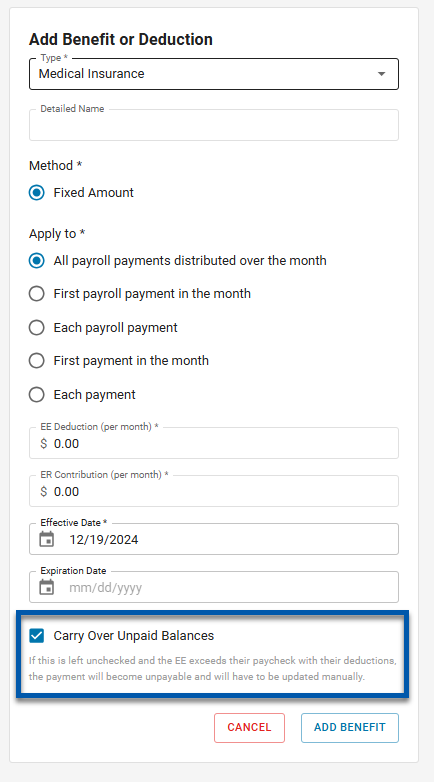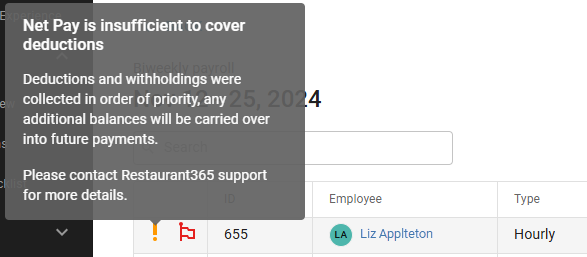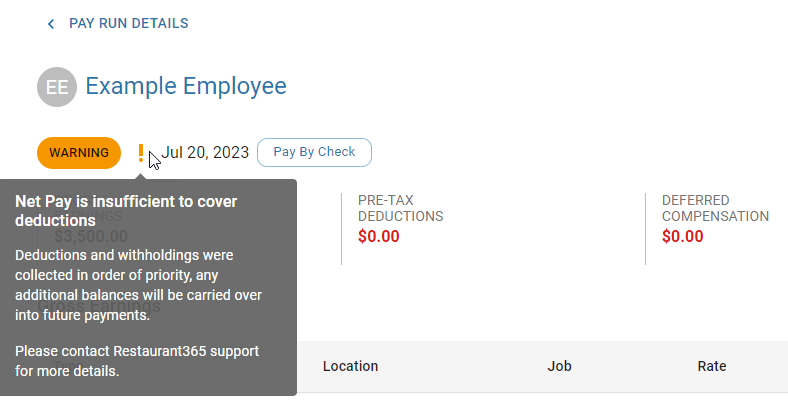This article reviews Net Pay Shortfalls and the resulting carryover process.
Overview
Net Pay Shortfalls occur when an Employee's net pay is insufficient to cover all required tax withholdings, deductions, and garnishments. This frequently happens when an Employee has previously paid earnings, such as cash tips, and has already received the majority of their gross pay. When this occurs, their hourly earnings do not cover the associated taxes and/or deductions, and a Net Pay Shortfall occurs.
When a Net Pay Shortfall occurs, the Employee's paycheck will be $0.00 (zero dollars).
Withholding shortfalls will be handled in the following ways:
Deduction Withholding Shortfalls:
Will be carried over to the next paycheck.
If the next paycheck also results in a Net Pay Shortfall, withholdings are carried over to subsequent paychecks until they are resolved by the Employee’s earnings or cleared.
Only deductions with the 'Carry over unpaid balances' setting will be carried over (see the configuring deductions for carryover section below).
Tax Withholding Shortfalls:
Will not be carried over to the next paycheck to be withheld.
Will be recorded on paystubs in Uncollected Taxes and Carryover Balances for reporting purposes.
Are automatically cleared at the end of the year.
Payroll Journal Entries will only post actual withholdings and will not include any Carryover Balances. The 'Negative Balances' report within Workforce displays all Carryover Balances.
Configuring Deductions for Carryover
Only deductions with the 'Carry over unpaid balances' setting enabled can be carried over. If an Employee does not have enough net earnings to cover deductions without this setting, the deductions will not be carried over and the Employee will be 'Unpayable'.
The 'Carry over unpaid balances' setting is part of the deduction settings found on the Payroll tab of Employee Records.

Order of Operations
Withholdings are processed in order, collecting any amount possible, and carrying over any additional balances. Tax withholdings proportional to the Standard Earning amount for the Payment are withheld first. All remaining taxes, pre-tax deductions, post-tax deductions, and post-tax garnishments are then associated with Previously Paid Earnings and withheld second.
Withholdings are calculated and withheld as follows:
1) Withholdings are calculated for Gross Earnings, then broken down by Standard Earnings and Previously Paid Earnings:
Gross Withholdings based on Gross Earnings are calculated
Total Withholdings are calculated as (Gross Earnings + Previous Carryover)
Standard Earnings Withholdings for taxes are calculated as (Total Withholdings * (Standard Earnings / Gross Earnings))
Previously Paid Earnings Withholdings for taxes are calculated as (Total Withholdings * (Previously Paid Earnings / Gross Earnings)).
2) Standard Earnings Withholdings are withheld in the following order:
Social Security Tax
Medicare Tax
Federal Income Taxes
State Income Taxes
Local Income Taxes
3) Previously Paid Earnings Withholdings are withheld in the following order:
Social Security Tax
Medicare Tax
Garnishments (order they appear on the employee record)
Pre-Tax Deductions (order they appear on the employee record)
Post-Tax Deductions (order they appear on the employee record)
Federal Income Taxes
State Income Taxes
Local Income Taxes
Only deductions with the 'Carry over unpaid balances' setting will be carried over (see the configuring deductions for carryover section above). Taxes will not carry over unpaid balances.
Viewing Carryover Balances
Carryover Balances can be viewed on the Pay Run Details page and the Payment Details page.
Pay Run Details
When Net Pay Shortfalls is enabled, the Pay Run Details page will indicate which Payments have Carryover Balances with an '!'. Hovering over the '!' will display the following message:
'Net Pay is insufficient to cover deductions. Deductions and withholdings were collected in order of priority, any additional balances will be carried over into future payments.'

Clicking on the Payment line will open the associated Payment Details page.
Payment Details
When Net Pay Shortfalls is enabled, the Payment Details page will have additional columns which display the 'Collected' amount and 'Carryover Balance' for the Payment. These columns are only displayed if the Payment has Carryover Balances.

If the Payment has a Net Pay Shortfall, a '!' will be displayed at the top of the page, next to the date. Hovering over the '!' will display the following message:
'Net Pay is insufficient to cover deductions. Deductions and withholdings were collected in order of priority, any additional balances will be carried over into future payments.'

Resetting Carryover Balances
Automatic Tax Withholding Reset
At the end of each calendar year, Net Pay Shortfalls for Taxes are automatically reset to zero. Any remaining balances need to be resolved by the Employee when filing their annual tax return.